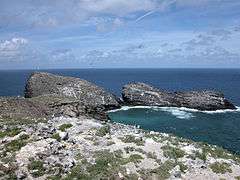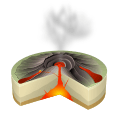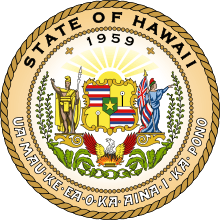Necker Island (Hawaii)
|
Necker Island Archeological District | |
|
On top of Mokumanamana | |
| Nearest city | Pu'uwai, Ni'ihau, Kaua'i County Hawaii |
|---|---|
| Area | 45.193 acres (182,890 m2) |
| NRHP Reference # | 88000641[1] |
| Added to NRHP | June 13, 1988 |

Necker Island (Hawaiian: Mokumanamana) is a small island in the Northwestern Hawaiian Islands. It is located at 23°34′35″N 164°42′0″W / 23.57639°N 164.70000°WCoordinates: 23°34′35″N 164°42′0″W / 23.57639°N 164.70000°W in the Pacific Ocean, 155 miles (135 nmi; 249 km) northwest of Nihoa and 8 miles (7.0 nmi; 13 km) north of the Tropic of Cancer. It contains important prehistoric archaeological sites of the Hawaiian culture and is part of the Hawaiian Islands National Wildlife Refuge within the Northwestern Hawaiian Islands National Monument.
The United States Census Bureau reports its land area as 45.193 acres (182,890 m2).[2] The island is rocky with steep sides and has very little soil. Its highest elevation is 277 feet (84 m). The island is named after Jacques Necker, a finance minister of Louis XVI.
Description
Few signs of long-term human habitation have been found. However, the island contains 33 stone shrines and stone artifacts much like those found in the main Hawaiian Islands. Because of this, many anthropologists believe that the island was a ceremonial and religious site. According to the myths and legends of the people of Kauai, which lies to the southeast, Necker Island was the last known refuge for a race of mythical "little people" called the Menehune. According to the legend, the Menehune settled on Necker after being chased off Kaua'i by the stronger Polynesians and subsequently built the various stone structures there. Visits to the island are said to have started a few hundred years after the main Hawaiian Islands were inhabited, and ended a few hundred years before European contact. French explorer Jean-François de La Pérouse was the first European to visit the island, in 1786. The island is named after Jacques Necker. The islands were formally annexed in 1894 by the Provisional Government of Hawaii.
Because of the island's usage by Native Hawaiians as a ceremonial and religious site in Ancient Hawaii, the island was added to the National Register of Historic Places in 1988.
Gallery
 Annexation ceremony of Mokumanamana (Necker Island) for the Provisional Government of Hawaii, May 27, 1894
Annexation ceremony of Mokumanamana (Necker Island) for the Provisional Government of Hawaii, May 27, 1894 Necker Island, Hawaii
Necker Island, Hawaii Moʻo Head, the westernmost point of Necker Island
Moʻo Head, the westernmost point of Necker Island
See also
References
- ↑ National Park Service (2007-01-23). "National Register Information System". National Register of Historic Places. National Park Service.
- ↑ Necker Island: Block 1001, Block Group 1, Census Tract 114.98, Honolulu County, Hawaii, United States Census Bureau.
Further reading
- Evenhuis, Neal L. (ed.); Eldredge, Lucius G. (ed.) (2004). Natural History of Nihoa and Necker Islands. Bishop Museum Bulletin in Cultural and Environmental Studies; No. 1. Honolulu, Hawaii: Bishop Museum Press. ISBN 1-58178-029-X. Cite uses deprecated parameter
|coauthors=(help) - "Necker Island". The Columbia Gazetteer of North America. Columbia University Press. 2000.
External links
| Wikimedia Commons has media related to Necker Island. |
- Northwest Hawaiian Islands Multi-Agency Education Project "Necker Island"
- Janeresture.com: Necker Island
- PBS Ocean Adventures website: Quick Facts on Necker Island
- NOAA Essay
- Papahānaumokuākea Marine National Monument Information Management System


